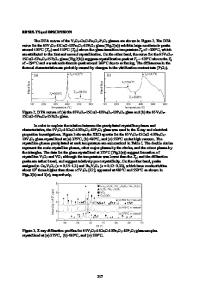Effect of heat treatment on structure and properties of cathode materials for V 2 O 5 lithium-ion batteries
- PDF / 2,212,412 Bytes
- 10 Pages / 595.276 x 790.866 pts Page_size
- 78 Downloads / 311 Views
Effect of heat treatment on structure and properties of cathode materials for V2O5 lithium‑ion batteries Yanjiao Zhang1 · Zhengguang Zou1 · Shangwang Le1 · Shengyu Li1 · Jie Liu1 Received: 7 September 2019 / Accepted: 16 January 2020 © Springer Science+Business Media, LLC, part of Springer Nature 2020
Abstract The layered vanadium pentoxide (V2O5) application has a good development potential in lithium-ion battery cathode materials. In this paper, vanadium chloride ( VCl3), terephthalic acid, and ethanol were served as crude materials to produce precursors of vanadium-based metal organic frameworks by simple solvothermal method. Porous vanadium oxides were synthesized by heat treatment at different temperatures. The results show that the vanadium pentoxide cathode material has a better electrochemical charge and discharge performance and steady cycle by heat treatment of the precursor at 600 °C. The specific capacity of first discharge of the vanadium pentoxide cathode material obtained by heat treatment at 600 °C reached to 324 mAh/g, and when the current density is 50 mA/g, the capacity retention ratio is still 50.6% after 100 cycles. The capacity retention ratio was increased by 16.6% compared to the heat treatment temperature at 400 °C.
1 Introduction The extensive consumption of fossil fuels has resulted in high levels of environmental pollution, prompting efforts to explore and develop renewable energy sources [1]. Lithiumion batteries are widely applied to some energy storage systems owing to their high energy density, high voltage and long service life [2]. So lithium-ion batteries have a great application potential in portable electronic equipment [3, 4]. The electrode materials of lithium-ion batteries, especially the cathode materials, have decisive effect on their performance. At present, this is mainly to improve electronic conductivity by adding conductive materials, improving synthesis, and ion doping [5]. The nanostructured vanadium pentoxide (V2O5) has a high theoretical capacity (each V2O5 deintercalates three Li+ to make capacity of up to 441 mAh/g), especially the layered V 2O5. The structure and various valence states of vanadium can provide multiple redox pairs, of which V5+/V4+ is the most attractive in the deintercalation of L i+ [6–8]. Vanadium pentoxide (V2O5) has a layered structure formed by co-edge and co-corner of V O5 quadrangular pyramid. The top V–O bond is a double bond and the length is shorter than the other four [9, 10]. This * Zhengguang Zou [email protected] 1
College of Materials Science and Engineering, Guilin University of Technology, Guilin, China
two-dimensional layered structure facilitates the intercalation–deintercalation of lithium ions, so V 2O5 is a potential candidate for lithium battery cathode materials [11]. However, the V 2O5 lithium-ion diffusion coefficient ( 10−12 cm2/s) and the conductivity ( 10−2 ~ 10−3 s/cm) are relatively small [12], resulting in a slower charge and discharge rate, and in the lithium-ion intercalation–dein
Data Loading...











